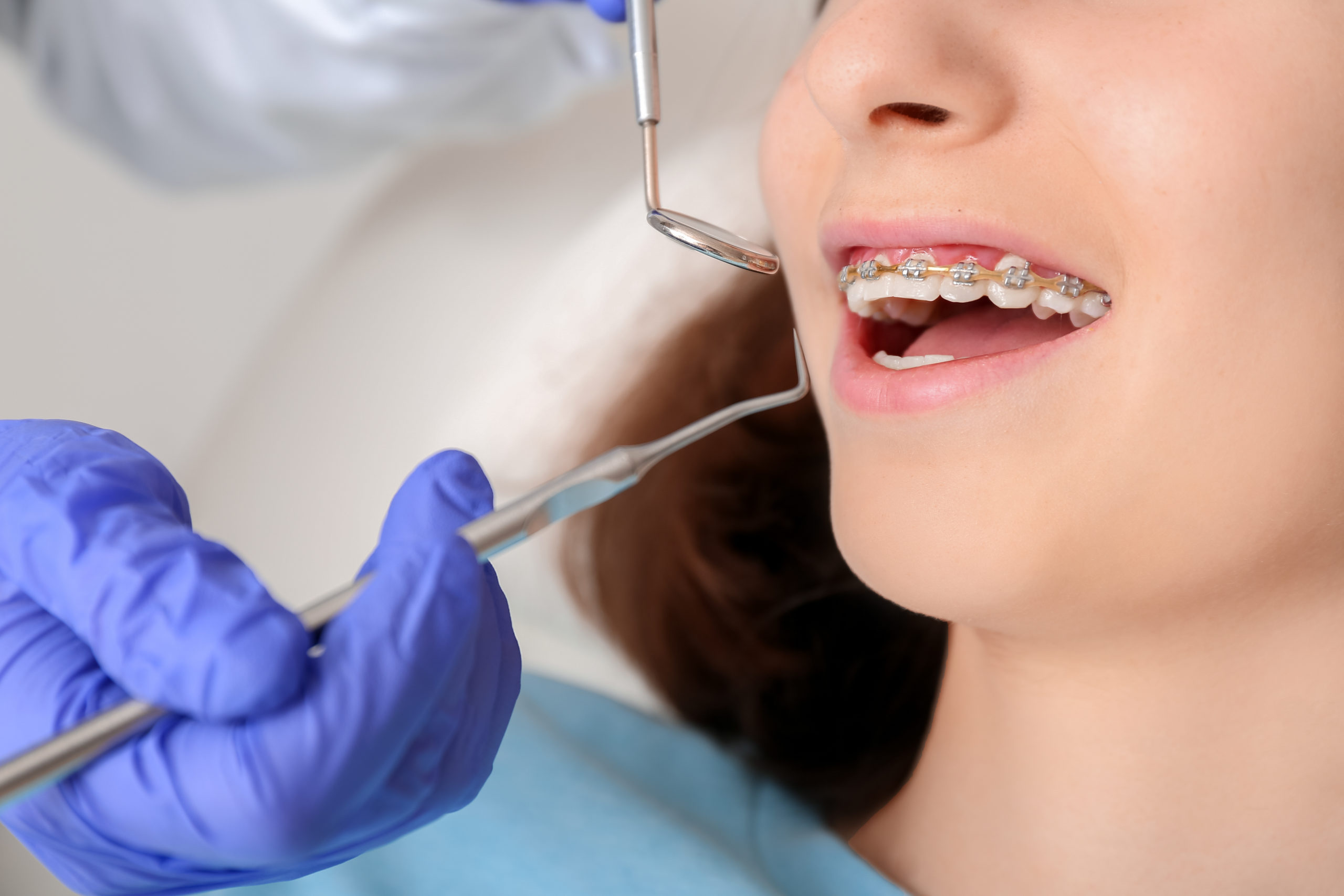
If you’re one of my El Dorado Hills braces patients, then I know you’re well aware of how important it is to keep your teeth and gums clean and healthy throughout your treatment. While plaque removal is always crucial, it’s even more key when you have braces. Maintaining outstanding oral hygiene is worth the extra effort and will help you get the results you want. In this post, I’ll be covering everything you need to know about cavities with braces.
Do Braces Cause Tooth Decay?
No, braces do not cause tooth decay. Instead, it’s the acids in plaque that cause tooth decay. Here’s how it works:
- Everyone has bacteria in their mouth and the bacteria mix with food and saliva to form a sticky film called plaque that clings to the teeth. The bacteria in plaque feed on the sugars and starches you eat and drink, and when they do, they produce acids. The acids attack your tooth enamel and leach minerals from it.
- When plaque isn’t removed, it hardens into tartar, which can’t be eliminated at home with regular brushing and flossing. The tartar sits on the teeth until you have a professional cleaning at your dentist’s office, further increasing those acid attacks.
- Thankfully, our bodies have natural defenses against the acid. The minerals in your saliva, as well as fluoride from water, toothpaste, and other sources replace the lost minerals. This is called remineralization.
- There is a constant battle going on in your mouth between demineralization (losing minerals) and remineralization. As long as remineralization happens more often than demineralization, you’ll be fine. However, if you don’t regularly remove plaque, you eat a lot of sugary and starchy foods, or you snack constantly, demineralization will start to win, causing more minerals to be lost, resulting in tooth decay.
- Sometimes, a white spot will show up where minerals were lost. These white spots on the teeth, technically called decalcification, are the earliest signs of tooth decay. At this point, you may be able to stop the decay from getting worse or even reverse it with excellent oral hygiene, limiting sugars and starches, and treatment from your dentist.
- If the tooth decay process keeps going and minerals continue to be lost, eventually, the enamel will be destroyed and a hole will form in the tooth. These holes are called cavities and they’re permanent damage that a dentist has to repair.
So, as you can see, the tooth decay process is pretty involved and braces don’t directly cause tooth decay or cavities. However, they can be a risk factor for developing cavities if you don’t practice excellent oral hygiene. This is because the brackets give plaque more places to hide and it takes more effort to remove it.
Other risk factors for tooth decay include eating a lot of sugary and starchy foods, poor oral hygiene, dry mouth, age, frequent snacking or sipping, lack of fluoride, and misaligned teeth.
Can You Get Braces With Cavities?
You can get braces if you have cavities as long as the cavities are treated before you start orthodontic treatment. We’ll also want to make sure your teeth, gums, and supporting bone are healthy overall, so that we can safely and effectively move your teeth. If you do have issues like cavities or gingivitis, I can team up with your dentist to help you get to a place where your smile is healthy enough to begin braces or Invisalign® treatment.
Why is it so Important to Avoid Cavities With Braces?
No one wants cavities at any time, but avoiding cavities with braces is crucial. This is because:
- Teeth move most efficiently in a healthy mouth. When your teeth and gums are in top-notch shape, your braces treatment will finish on time, and we’ll be able to achieve the tooth movements we planned from the start.
- Getting cavities with braces will mean more visits to your general dentist and our office. I’ll have to work out a plan with your dentist to treat the cavities and keep a closer eye on your oral health. As awesome as our office is, and I’m sure your dentist’s office is, you probably don’t want to spend all of your free time with us.
- Your braces treatment could take longer due to the need to have your cavities treated. In extreme cases, you could have to have your braces removed so the cavity can be repaired. This will add to the time and expense of your orthodontic treatment.
- When you get braces, you’re investing in your smile. Obviously, you’ll want it to look its absolute best when you finish treatment, and that won’t happen if you have cavities, stains, or white spots after braces. We can get to your best, most beautiful, confident and natural smile with excellent oral hygiene.
How to Tell if You Have a Cavity With Braces
If you’re wondering how to know if you have a cavity with braces, the answer is, visit your general dentist! Throughout your orthodontic treatment, you’ll want to continue to see your general dentist at least once every six months (or more often if they recommend it) for an exam and cleaning.
Your dentist will check for tooth decay and other issues. They may even take dental x-rays, which can detect cavities under braces, between your teeth, and in areas that aren’t visible.
While early tooth decay frequently has no symptoms, if you experience any of the common signs of a cavity in between your routine dental visits, call your dentist and make an appointment as soon as possible. The earlier the issue is treated, the easier and more affordable treatment will be and the less likely it will disrupt your braces treatment.
Oftentimes, people think that because they don’t feel pain immediately that a cavity can be addressed later. By the time you feel significant signs or symptoms of a cavity, it could mean that much more extensive dental work will be necessary.
Signs of a cavity include:
- Sensitive teeth
- Sharp pain when eating or drinking something hot, cold, or sweet
- Tooth pain when biting down
- White, gray, brown, or black spots on the teeth that don’t disappear when you brush
- A toothache that occurs without an apparent cause
- Holes or pits in the teeth
How are Cavities Treated When You’re Wearing Braces?
How a cavity is treated when you’re wearing braces depends on where the cavity is located and how large it is. If you have areas of decalcification – those white spots we talked about that are early signs of decay – your dentist may give you specific hygiene instructions to follow and do a treatment, such as a fluoride varnish, to remineralize the area and prevent the decay from getting worse.
For a small cavity that the dentist is able to easily access, they can usually treat it without removing your wires or brackets. They’ll numb your tooth, use a drill to remove the decay, and then fill the space left behind with a tooth-colored filling.
For a cavity under your braces, multiple cavities, or decay in a hard-to-reach place, the dentist might need our help to remove your braces wire and, sometimes, your bracket too. If that’s the case, they’ll treat your cavity (or cavities). Then, you’ll come to the Jeffrey Kwong Orthodontics’ office and I’ll bond the bracket back on the tooth and refit your braces wire to get your treatment back on track.
How to Prevent Cavities With Braces
Preventing cavities is always better than treating them! 90% of the work can be handled at home with regular oral hygiene routines. And, while braces require a little extra TLC to keep plaque away, the vast majority of my patients don’t have any tooth decay during their braces treatment.
Here are some tips to keep your teeth healthy and cavity-free while you have braces:
- Brush your teeth in the morning, after meals and snacks, and before bed using a soft-bristled toothbrush and fluoride toothpaste. If you or your child has trouble brushing effectively, we’re a PLAQUE HD® provider. The awesome plaque-identifying toothpaste turns plaque green, so you can see exactly what you missed and keep brushing until it’s gone. Ask a team member about it at your next appointment!
- Floss your teeth at least once daily, making sure to floss all the way up to and under the gumline. Flossing with braces will be way easier if you use a floss threader, special orthodontic flosser, or a product like SuperFloss.
- Enjoy starchy and sugary foods and drinks in moderation. When you do have something with sugar or starches in it, eat it or drink it in one sitting as part of a larger meal. Snacking frequently throughout the day or slowly sipping on a beverage will prolong the acid attacks on your enamel.
- Use an interdental brush, also called an interproximal brush, to carefully clean around your brackets. These tiny brushes are super effective at getting in tight spaces that are hard to reach with your toothbrush.
- Add a Waterpik, or water flosser, to the mix. While a Waterpik won’t take the place of regular flossing and will be an extra step, it’s an excellent tool for dislodging stuck food and washing away stubborn plaque.
- After having a drink of anything aside from plain water, or after a meal if you forget your toothbrush, rinse your mouth out really well with water.
- Use a fluoride mouthwash, especially if you’re prone to cavities. The extra fluoride will help remineralize your teeth and the swishing action can help clear out any food, bacteria, or plaque that wasn’t brushed or flossed away.
- Visit your dentist at least once every six months, or according to the schedule they recommend, for a dental exam and professional cleaning. Regular exams are the key to catching tooth decay before it progresses. During cleanings, the hygienist will be able to remove tartar that you can’t remove on your own, reducing your risk of cavities and gum disease. If you don’t already have sealants on your teeth, talk to your dentist at your next visit. Sealants can help to fill in the grooves, nooks and crannies that can harbor cavity bugs.
Have Questions?
If you have any questions about cavities with braces, reach out and I’ll be happy to help! Or, if you haven’t started treatment yet and you’d like to learn more about your teeth-straightening options, schedule a complimentary consultation at Jeffrey Kwong Orthodontics in El Dorado Hills, CA.

